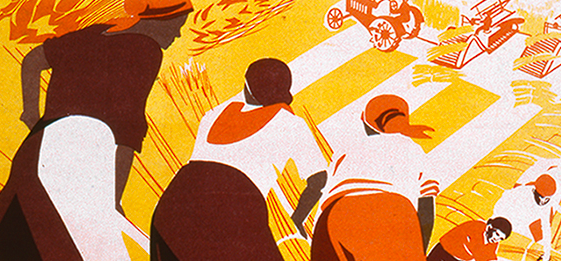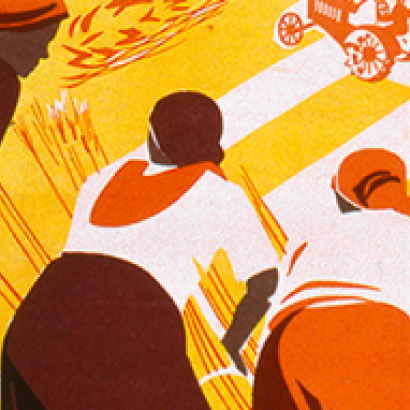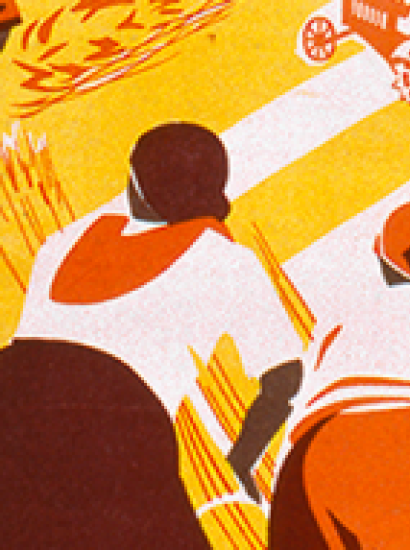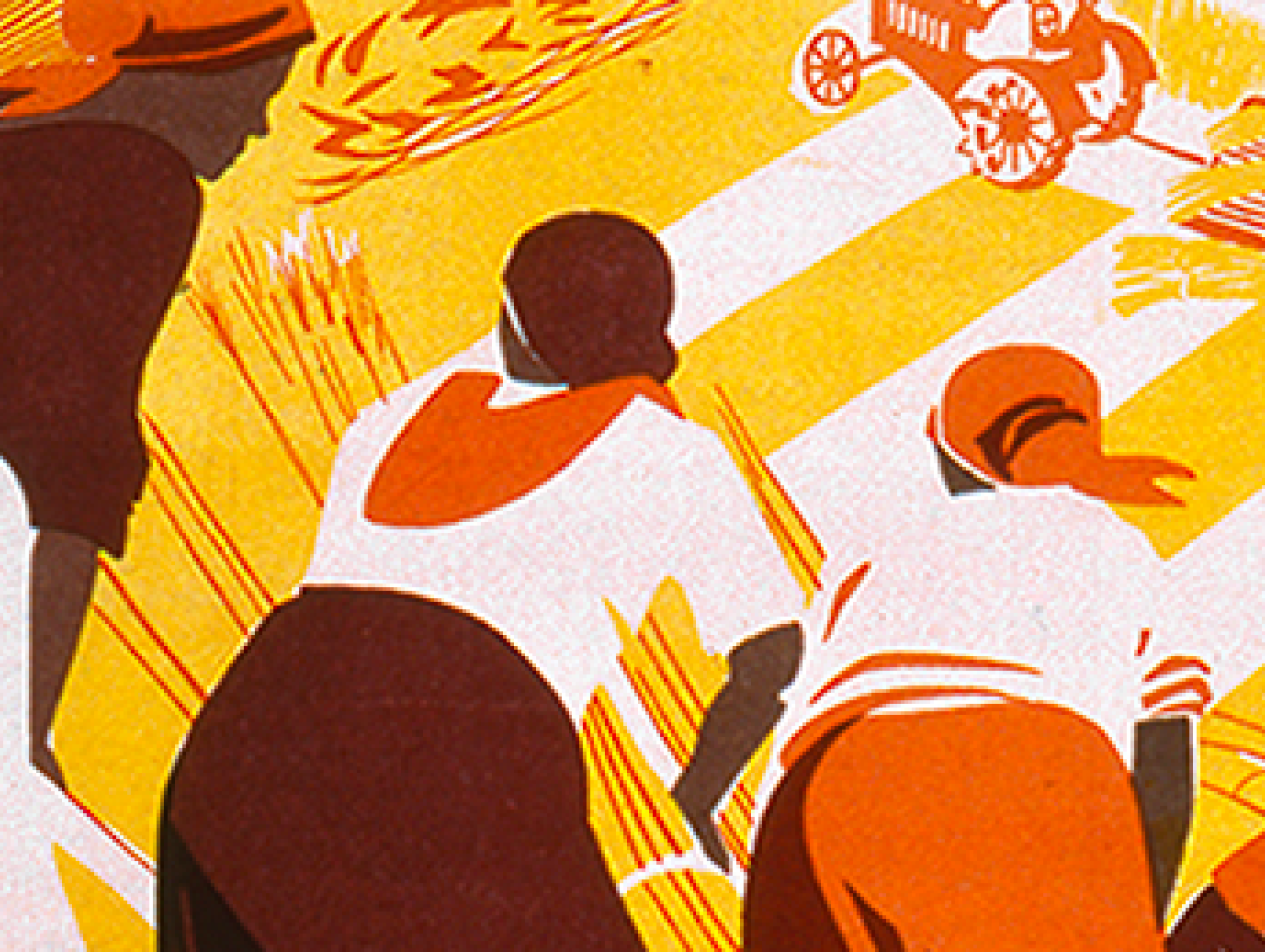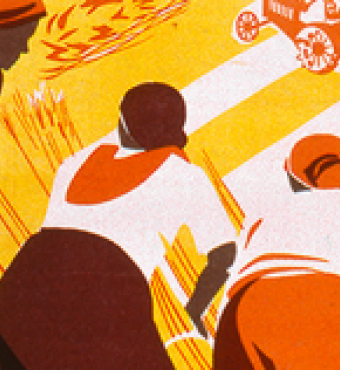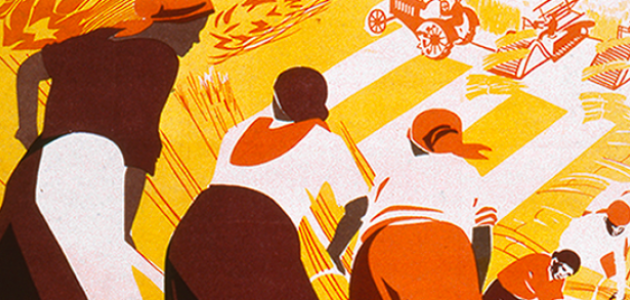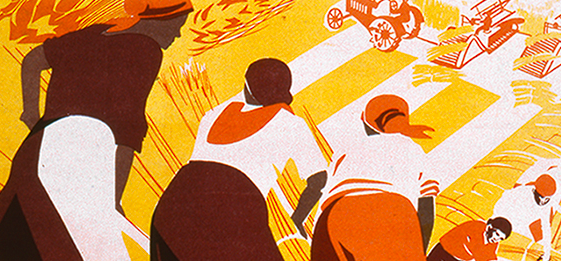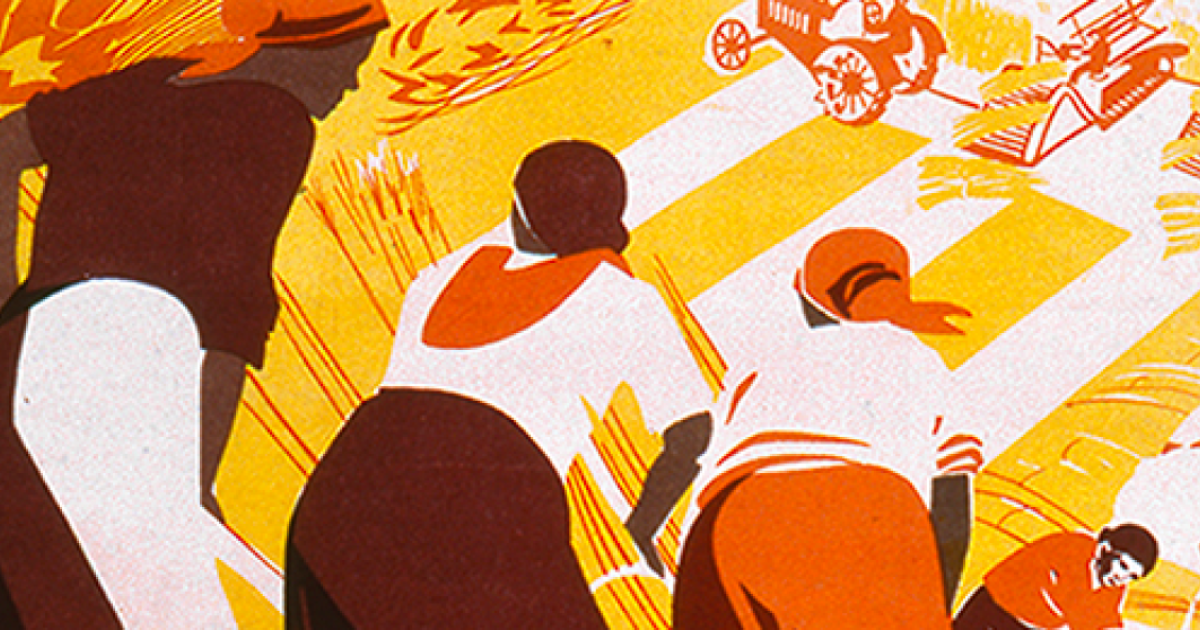Editor’s note: The following essay is an excerpt of the Hoover Press book Hammer, Sickle, and Soil: The Soviet Drive To Collectivize Agriculture.
Russia entered the modern age during the reign of Peter the Great (r. 1682–1725). Among his first acts as sole ruler, after his half-brother and co-ruler, Ivan V, died in 1696, was to spend eighteen months in Europe, learning everything he could from a continent in the dramatic throes of a transformation more radical than any region of the world had ever undergone. The printing revolution, the Renaissance and Reformation, the age of exploration and empire building, the scientific revolution, a commercial revolution involving transoceanic trade and stock exchanges, the Dutch War of Independence, the English Glorious Revolution—all had unleashed the creative skills and abilities of millions of Europeans, raised standards of living, begun unlocking the secrets of nature, empowered individuals in matters of faith and politics, and soon would launch the Industrial Revolution and the making of the modern world. Peter loved Europe’s dynamism and the inventiveness of its people and resolved to remake his country in its image.
He studied a dozen trades—shipbuilding, dentistry, mapmaking, navigation, military science, engineering, and surgery, among others—and brought back with him specialists in these and other fields. He also sent hundreds of young Russians to study in Europe. Over the next quarter century, Peter built up a European-style bureaucracy and diplomatic corps, modernized the army, created a navy, instituted state control over the church, commissioned detailed maps of Russia, founded an entirely new city as his capital (Saint Petersburg), introduced European artistic and architectural methods and styles, issued decrees and political treatises explaining in rational terms his goals and purposes, dramatically expanded printing, simplified the Cyrillic alphabet, sponsored the publication of handbooks of all kinds, expanded education, inculcated new ways of speaking and thinking, promoted European manners of dress and grooming, established an Academy of Science and an Academy of Arts—one could go on and on.
The point is that in bringing about these staggering changes, Peter was setting up Europe as a model for Russia, thus making it the world’s first developing country. Russia became more dynamic, its elites better educated, its military more powerful. Within a century and a half, Russia’s greatest composers, writers, and scientists would rival those of any country in the world. At the same time, however, it perpetually fell short of its geopolitical rivals in military power, commercial prowess, and technological and industrial achievement. A thin layer of Europeanized elites grew apart from the bulk of the population, who remained tied to the land and wedded to pre-modern values and culture. To finance his grandiose projects, Peter promoted industrial development but also squeezed more taxes from the peasantry, the majority of whom were serfs. The state reigned supreme, jealously guarding its power, refusing to share authority even with the educated elites. Yet many political ideas emanating from Europe in the decades following Peter’s death emphasized power sharing, checks and balances, popular participation, and social justice. Russia’s rulers tried to shut out such ideas, while the intelligentsia—critically minded intellectuals emerging in the first half of the nineteenth century—zealously embraced them. Lacking institutions or rights enabling them to influence government policy, radical intellectuals treated European doctrines of social and political change as infallible guides to political understanding and action.
Russia’s rulers also tried to keep up with the latest European developments. Catherine the Great (r. 1762–96) corresponded with Voltaire and borrowed ideas from the French constitutionalist Montesquieu and the English jurist Blackstone. Her grandson, Alexander I (r. 1801–25), seriously considered granting a constitution to Russia and later marched into Paris with a grand coalition against Napoleon. His grandson, Alexander II (r. 1855–81), freed over 23 million serfs and created an independent judiciary—entirely by autocratic fiat. He was, however, assassinated by revolutionary activists for whom his reforms had not gone far enough. His son, Alexander III (r. 1881–94), crushed the radical opposition and launched Russia on a career of industrialization. Levying heavy taxes and exporting grain to buy machinery and build up gold reserves helped bring about a horrific famine in 1891–92, which killed roughly four hundred thousand people (a figure that would have been far higher without the government’s extensive relief efforts). The fact that Russia suffered such a calamity in an age when famines typically struck only colonial states like Ireland and India inspired public distrust and criticism. During the rest of Alexander’s reign and that of his son, Nicholas II (r. 1894–1917), intellectual discontent festered and swelled.
Marxism enjoyed particular favor among Russia’s intelligentsia because it purported to scientifically explain social and economic development in all countries and seemed to promise a path to the highest stage of human flourishing in the face of an apparently unshakable autocratic government and without the gradual and spontaneous emergence of political, social, and economic institutions witnessed in Europe. Neither the great mass of ignorant peasants nor authoritarian administrative officials and police, according to Russian interpretations of Marxism, could stop the march of history toward capitalism, through socialism, and ultimately to communism. In this drama, industrial workers, as participants in the most advanced sectors of the economy, would play the leading role.
The two main currents of Russian Marxism divided on the question of leadership. The Russian Social Democratic Workers Party split in 1903 into Bolsheviks, who insisted on centralized party control, and Mensheviks, who were more willing to trust historical forces and the class consciousness of the workers, meaning their alleged instinctive tendency toward socialist revolution. The leaders of both factions were westernizers, staunch believers in a universal path of progress, who rejected the idea of some special Russian path. They also, as consistent Marxists, mistrusted the peasantry as “petty bourgeois.” The chief Bolshevik leader, Vladimir Ulyanov, known as Lenin (1870–1924), was by all accounts fanatical in his Marxist faith, resolutely authoritarian, ruthless, single-mindedly committed to revolution, deeply self-righteous, and absolutely confident in his political judgment.
Beginning in the 1890s, thanks in part to government encouragement of railroad construction and foreign investment, Russia boasted one of the fastest-growing economies in the world. On the eve of World War I, its gross industrial output was fifth in the world and fourth in Europe. At the same time, its per capita national income was by far the smallest of the major European economies: in 1913, less than a third that of the United Kingdom and roughly half that of Austria-Hungary. Its population growth was extremely rapid, doubling over the course of the nineteenth century, increasing land hunger among the peasantry. The share of the urban population grew, too, from 6 percent in 1861 to 18 percent in 1913—a tremendous increase, though still a very low total relative to the major European countries (by comparison, 39.5 percent of the French population lived in towns in 1896). Russia was experiencing extremely fast development while remaining relatively backward. Such rapid change fueled mounting social tension.
Popular discontent broke out in a series of disorders beginning with major industrial strikes in 1896, student protests in 1899–1901, peasant uprisings in 1902, and anti-Jewish pogroms in 1903. Russia had been pursuing an expansionist foreign policy in the Far East, provoking the Japanese to attack the Russian Eastern Fleet at Port Arthur, which Russia had leased from China. In the course of the war, which went badly for Russia, mass unrest gripped the country, reaching a crescendo in October 1905 with a general strike that nearly shut down the economy. Nicholas II responded with the October Manifesto, promising civil rights and a representative institution. He partly went back on his promises but still granted a limited right to assembly, diminished censorship controls, and a bicameral legislature without whose approval few laws could be adopted.
Over the next several years the economy continued to expand, Russian culture flourished and took the world by storm, the peasantry dramatically expanded its landholdings at the expense of landowners, agricultural output increased by one-third (in 1900–1913), exports of grain rose by 50 percent (in the same years), literacy increased rapidly (73 percent of military recruits could read by 1913), and nearly a quarter of peasant households had taken advantage of a 1906 law permitting them to leave their rural communes and set up individual farms. Major revolutionary parties, including the Bolsheviks, had collapsed, from both repression and lack of popular support. A massacre of workers in a Siberian goldfield in April 1912, however, set off a spate of strikes and breathed new life into the worker movement, though labor was on the march in the major Western countries as well.
Contemporary observers were divided over Russia’s future. Edmond Théry (1854–1925), a well-regarded French economist and prolific author, predicted that “if developments in the major European countries continue from 1912 to 1950 as they did from 1900 to 1912: toward the middle of the present century, Russia will dominate Europe politically, economically, and financially.” Others were far less optimistic, but in July 1914 Russia became embroiled in a grueling world war against the greatest land power in the world—imperial Germany—and its allies. Russia mobilized 12 million soldiers. During the course of the war 1,700,000 were killed, 4,950,000 were wounded, and 2,500,000 were taken prisoner. Inflation was rampant. Munition shortages at the start of the conflict hindered the war effort, and bread shortages toward the end sparked popular unrest.
In February 1917, crowds took to the streets in Petrograd, troops mutinied, and the tsar abdicated. For the next several months, power and decision making were divided between liberals and socialists. Crime grew rife. Peasants seized and divvied up many large landholdings. Inflation frittered away the value of the ruble. Popular discontent sharpened.
In October, the Bolsheviks seized power in the name of worker and soldier councils, or soviets. Their first decrees were mostly popular, such as proclaiming an end to the war, approving peasant seizures of land, establishing an eight-hour working day, and granting self-determination to national minorities. Yet the Bolsheviks soon created a one-party dictatorship and a secret police with expansive powers (the Cheka). They also nationalized all banks, other large businesses, financial securities, and urban real estate. In March 1918, they had bought Russia’s exit from the war in exchange for one-third of its European territory, which was handed over to Germany (but Russia got most of it back when the war ended in November). In May, committees of the poor were tasked with seizing grain from the peasantry. Inevitably, a civil war broke out, with the Bolsheviks against most of the country. During the civil war, trading grain and other foodstuffs, instead of handing them over to the government at low fixed prices, became a crime punishable by death. Free enterprise and buying and selling goods on the free market were also outlawed. Such policies were known as “war communism.”
Thanks to superior military organization, unified political and military leadership, control of the country’s heartland and major lines of communication and transportation, a more compelling vision of the future, and the fear of most peasants that the anti-Bolshevik coalition might return private estates to the landlords, by early 1920 the Bolsheviks had won the civil war.
The country, however, lay in ruins. Industrial output had fallen to one-fifth of the prewar level, steel and iron manufacture to 3 percent. Major cities had lost half or more of the population. Livestock production had collapsed. The number of draft animals had fallen by a third. Peasant uprisings multiplied across the country. In early 1921, factory workers struck in Petrograd; sailors at the nearby fortress of Kronstadt rebelled. The Communist authorities supplied the workers with more food and clothing and crushed the rebellion with heavy firepower. Lenin also convinced his colleagues to “retreat on the economic front” by stopping grain confiscations and decriminalizing the retail trade in agricultural and other products. The retreat was to be temporary, because for Marxists not only private property but also free economic exchange had to be eradicated to build socialism.
Peasant uprisings continued into 1922, but again the rebels were no match for a battle-hardened army. The government also systematically disarmed the peasantry. Tragically, the widespread confiscation of grain, which had depressed planting, was exacerbated by an extreme dry spell. A horrific famine resulted. By the end of 1922, some 5 million people had died from starvation and disease. The government, unlike in 1891, provided little support to the hunger victims, nor did it allow civic organizations to help, except foreign agencies like the American Relief Administration. This assistance was decisive, however: without it, millions more would have died.
Sporadic but very serious hunger continued into 1924, yet big grain exports recommenced in 1923. Peasant unrest persisted. A massive rebellion broke out in Georgia in late August 1924. It was crushed, leaving many thousands dead. The repression was characteristically accompanied by religious persecution, since the Bolsheviks viewed “counterrevolutionary” peasants, capitalists, and the religious as inextricably bound together in opposition to building socialism. Spreading knowledge of the events worried peasants throughout the country. Heavy taxation, confiscation of property for failure to pay, and the high price of manufactured goods led to ongoing discontent in the countryside, which sometimes expressed itself in violent attacks against officials and rural correspondents of the state-controlled press (who many peasants believed were spies). In August 1924, for the first time, a key secret police summary report contained the rubric “kulak terror,” meaning violent attacks by well-to-do peasants against authority figures. (The Bolsheviks’ Marxist outlook required them to divide the population into social classes. In reality, there was very little social differentiation in the Russian countryside after the spontaneous land reform of 1917.)
All these problems in the villages led the Communist authorities at their October 1924 plenum of the Central Committee to enunciate a “face to the village” campaign. For the next year, the party paid attention to rural problems and strived to mend fences with the peasantry. At a Politburo meeting in January 1925, Mikhail Kalinin (1875–1946) pointed out that the typical “kulak” lived less well than the typical worker. In an April 1925 speech, Nikolai Bukharin (1888–1938), a leading Politburo member, denounced the fear of autonomous economic growth in the countryside, where hardworking peasants were afraid to buy farm implements because it would get them labeled “kulaks.” On the contrary, he asserted, “enrich yourselves, accumulate, develop your farms.” (Even at the time he was roundly criticized for such a “pro-capitalist” assertion; later it helped cause his doom.) Thousands of party members were sent to the countryside to work with the peasants and even to learn from them, but neither the helpers nor helpees enjoyed this collaboration very much. In fact, the city folk, who were already deeply suspicious of the peasantry, were often horrified by what they saw: political ignorance, illiteracy, deep suspicion of the urban world, resentment of the higher standard of living and greater privileges of industrial workers, brawling, disinterest in building socialism, efforts to co-opt rural Soviets for their own ends, intermarriage of government officials and “kulaks,” drunkenness, and corruption. Many local officials, who were ill disposed toward rural folk to start with, continued to resort to coercive methods. Since grain collections did not increase, the policy was abandoned in late 1925.
Lenin’s New Economic Policy (NEP) nevertheless worked like magic. By 1926, industrial production slightly exceeded prewar levels (of course, the European countries had advanced vastly farther), and more land was being cultivated, though the grain harvest still fell short (despite continued population growth). Grain was important: 80 percent of all arable land was sown to grain, and it was easy to export. The state dominated heavy industry and large-scale manufacturing, but private entrepreneurs controlled handicraft production, much of the retail sector, and nearly the whole of agriculture. During the revolution, the peasantry had seized all of the agricultural land and had forced back into the communes those peasants who had set out on their own starting in 1906. As a result, the agricultural sector was less efficient, more old-fashioned in its methods, and less oriented toward the long-distance market than before 1917—but still vastly more productive than during war communism.
Lenin and other Bolshevik leaders hoped to draw the peasantry into the cooperative sector, where they would join together to buy, sell, provide credit, or produce food, both to create economies of scale and to wean the peasantry away from the evils of the market. After all, according to Marxist doctrine, peasants were by definition petty bourgeois and indeed enemies of the proletariat. The cooperatives, Lenin hoped, would gradually suppress private trade, defend poor and middle peasants against the “kulaks,” serve as a “school of collective economics,” overcome the individualistic character of the peasantry, and expand socialist construction in the village. By 1927, half of all peasants made use of consumer cooperatives. Yet most peasants remained skeptical of producer and credit cooperatives. The better-off members tended to dominate them, few cooperatives achieved a high level of efficiency, many seemed to have a political agenda, and they were gradually integrated into the state apparatus. Many Bolsheviks also looked askance at them, for they remained a form of private ownership. Lenin himself had vacillated about whether cooperatives tended more to foster the development of capitalism or socialism. All the Bolsheviks looked to the eventual creation of a colossal network of big, centrally controlled, highly mechanized socialist farms. They simply disagreed about how soon.
Leaders compensated for the “economic retreat” by clamping down on the “political front.” (Leading Bolsheviks like Lenin viewed the struggle for socialism in militaristic terms.) The same party congress that adopted the NEP also imposed a ban on factions within the Communist Party. Not only were no other political parties allowed to take part in government, but even within the ruling Communist Party it became illegal to form coalitions or groupings. Leaders of other political parties, as well as of organizations with a potential for political influence, like the Russian Orthodox Church, suffered arbitrary arrest, trial, and execution, as well as other forms of persecution.
Despite official commitment to the smychka, the officially proclaimed union of peasants and workers, most peasants remained deeply mistrustful of the Communist authorities, who for their part saw the peasants as ignorant and superstitious. Officials who came to the villages typically had no idea about farming, but one still had to listen to them and even implement their orders. They tended also to be nicely dressed and far better-off than the villagers. Some locals referred to them as “nomads.” The best disposed aimed to discipline, civilize, and Sovietize their charges; the worst, to swindle, cheat, abuse, and lord it over them. Many drank plentifully and caroused. Given their low salaries, most saw bribes as a basic form of compensation. All the peasants really wanted was economic freedom, reasonable taxes, fair prices, and the right to benefit from the fruits of their labor. They were willing to follow all the rules and abide by the law, so long as this did not ruin them financially, which in many cases it unfortunately did. Perhaps surprisingly, many peasants had more faith in the party leaders in faraway Moscow, whom they considered “ours” and believed were trying to “bring about socialism, that is the reign of God on earth.” Still, few peasants had the intellectual ability to formulate a political position, much less a program. Although one can think of the NEP as a sort of “golden age of the Russian peasantry,” most peasants during this era were quite unenthusiastic about the present and pessimistic about the future. The party leaders, for their part, were pursuing contradictory goals. On the one hand, they wanted agricultural development, but on the other they were afraid of stronger peasant households and the “class warfare” this would bring.
Lenin had suffered a series of strokes, leaving him debilitated from early 1923 and killing him in January 1924. A struggle for power had already begun. Joseph Stalin (1878–1953) had many disabilities: he was a Georgian who spoke Russian with an accent, was short and had a pockmarked face, lacked the intellectual talents of other Bolshevik leaders, and was a poor orator. He was nonetheless in an especially strong position. As general secretary of the Central Committee of the Communist Party, he could divvy out to his supporters the exponentially increasing patronage jobs controlled by the party. Until Leon Trotsky (1879–1940) was expelled from the Soviet Union in early 1929, Trotsky’s charisma, prestige, rhetorical skill, and intellectual brilliance made him the most obvious potential dictator and therefore the greatest threat to the other leaders. By contrast, Stalin feigned humility and presented himself as a team player, eager to defer to his colleagues as a variety of coalitions formed, first against the “left deviation” of Trotsky and then against the “right deviation” of Bukharin.
Trotsky and his supporters advocated rapid industrialization. Building up industry required huge investments. Yet all obvious sources of wealth had already been expropriated, including the church, the nobility, the merchantry, the state gold reserves, businesses, and most personal riches. Moreover, the former government’s massive debts to the leading European countries had been repudiated. Who would lend them more? The peasantry was really the only major source of wealth in the country, and certainly the government desperately needed to obtain a portion of their agricultural output. But to do so, it needed manufactured products to exchange, which brought one right back to the problem of industrial weakness. So Trotsky advocated squeezing the peasantry. The party majority during the first years of the NEP, whose chief spokesman was Bukharin, argued for maintaining Lenin’s policy of smychka (alliance). If the peasants prospered, it was asserted, they could pay more taxes, purchase more industrial goods, and help grow the economy without coercion or other mistreatment. Since the peasantry made up 85 percent of the population, antagonizing it would be political suicide. Stalin supported this position. But he also began, as early as 1924, to set out in his own direction, revising Leninism significantly. Back in fall 1923, a Moscow-backed insurrection in Germany had failed, dealing a crushing blow to both leading and rank-and-file activists in the USSR. Stalin now argued that, despite Russia’s backwardness, its industrial workers, or proletariat, could “build socialism in one country,” even if no further socialist revolutions occurred in the leading European countries—the only hope for the success of the Russian Revolution, according to Lenin, Trotsky, and other leading Bolsheviks. It is not hard to see why Stalin’s new theory was popular among ordinary Russians.
Once Trotsky had been defeated, and in 1927 expelled from the Communist Party, Stalin began to inch toward Trotsky’s economic position. He commissioned a study purporting to show, with a fudging of statistics, that only half as much grain had been brought to market in 1927 as in 1913. The supposed explanation was the loss of big, efficient estates to peasant land seizures. The Bolshevik answer was not, of course, to return the property to big landowners, but instead to gather the peasants into larger communal organizations—into big, modern, technologically advanced farms—to collectivize them. The trouble was, few Russian peasants wished to give up their autonomy and hand over their land allotments and livestock to an anonymous collective, despite various incentives provided by the state. (Nor was there the industrial capacity to produce sufficient farm machinery.) So the party leadership hiked the taxes on the peasantry (especially the better-off), slashed the official price paid for grain, excluded private traders from grain procurement, and raised the cost of manufactured goods. The purpose of all of these policies was to extract wealth from the peasantry, though in a gradual fashion. Already beginning in August 1926, the secret police had received orders to facilitate grain deliveries. They also arrested thousands of private traders and “kulaks.” Many peasants responded by withholding their produce, planting other crops, failing to pay their taxes, and refusing to buy factory-made merchandise. In 1927 and 1928, the government felt the pinch, the more so as it had planned to increase industrial development, for which it needed grain exports to trade for imports of machinery. In fact, the situation was so bad that on March 11, 1927, strict orders were given to all publications within the state-controlled information system (essentially all the country’s media) forbidding any mention of problems with grain supply.
A number of factors came to Stalin’s aid. From 1926, the Soviet leadership worried more and more about rural crime, waves of arson, violent attacks against officials, hooliganism, “banditry,” growing “kulak” influence, and a unified front within the village against party and state. Indeed, fewer and fewer Communists—and more and more “kulaks”—were elected to local office in the countryside. The closer officials looked at the Russian countryside, the more it appeared violent, primitive, menacing, and lawless. In many regions, criminal gangs made it impossible to travel from village to village in safety. The authorities feared the prestige of bandits and criminals in general. Even Bukharin, the great defender of the peasants, repeatedly called for an offensive against the “kulaks,” for example, in January 1926 and October 1927.
In reality, few peasants could be considered wealthy. An official survey of 1927 found that 3.2 percent of households owned on average 2.3 draft animals and 2.5 cows. These were the rich. By contrast, 80 percent of households possessed no draft animals at all, and 57 percent had no cow. Only 1.4 percent of peasant households had more than 43 acres of sown cropland, 3.7 percent had 27 acres or more, and 36.7 percent less than 5.5 acres, whereas the average farm in the United States had nearly 200 acres. Yet the Marxist concept of class conflict required the Bolsheviks to dream up a rural bourgeoisie. The handiest marker in this regard seemed to be hiring labor. Yet only 1 percent of rural households hired more than one worker, most worked only part-time, many families with a lot of mouths to feed but few work-capable members hired labor, and better- off households often avoided hiring labor for fear of being labeled “kulaks.” Indeed, secret police reports repeatedly noted that most peasants saw not class stratification but work stratification, with the lazy and the stupid at the bottom of the village hierarchy.
International tensions and capitalist “encirclement” of the USSR also troubled the party leadership. The slaughter of Chinese Communists in Shanghai in April 1927, the expulsion of the Soviet trade mission from the United Kingdom on charges of espionage in May, and the assassination of the Soviet ambassador to Poland in June underlined the hostile global environment and suggested that war might be imminent. The party leadership used the events as a pretext to beef up the secret police and to conduct “counterrevolutionary” operations. Thousands were searched and arrested around the country but especially in the countryside. The state-controlled media played up the threat of war, leading to panic, hoarding of foodstuffs, and widespread slaughter of livestock. Unemployment soared. Popular discontent swelled. Secret police investigators uncovered pervasive antiwar and even defeatist sentiment in July and August. Orders went out on September 12 to make no mention in the press or public appearances about grain exports. This regime of tight information control and secrecy made it easier to launch a frontal assault against the peasantry when the time came.
Preparations for an attack were in fact under way in fall 1927. In mid-October, the government authorized the secret police (now called the OGPU) to arrest on their own authority both traders engaged in “speculation” and officials who abetted them. On October 29, Genrikh Iagoda (1891–1938), the head of the OGPU, proposed empowering his agency not only to arrest but also to sentence “speculators” administratively. Ironically, Stalin rejected the proposal as going too far. It seems hard to imagine he was not feigning moderation.
The announcement, during the celebration of the tenth anniversary of the October Revolution a couple of weeks later, of a seven-hour workday for factory workers outraged peasants, who already considered urban workers both lazy and coddled by the state. By December, the secret police was warning of a mounting confrontational atmosphere among the peasantry. In mid-December, at the Fifteenth Party Congress, which expelled Stalin’s former allies, Lev Kamenev (1883–1936) and Grigory Zinoviev (1883–1936), from the party, the leadership made a commitment to the gradual collectivization of agriculture, but the tone was moderate. Stalin himself proclaimed that one had to do away with the “kulaks” only by legal means. “Those comrades,” he argued, “are wrong who think that it is possible and necessary to put an end to the kulaks by means of administrative measures, through the GPU: give an order, affix a seal, and that settles it. That is an easy way, but it is far from being effective. The kulak must be defeated by means of economic measures and in conformity with Soviet law. Soviet law, however, is not a mere phrase.” It seems unlikely he meant it. More than other party leaders, Stalin viewed the peasants as a largely undifferentiated mass, for the most part hostile to the party, the workers, and the building of socialism. Throughout the fall he warned that “kulaks” were purposely withholding grain and convincing middle peasants to do the same. He also knew that the state grain procurements were way down from the previous year.
Soon after the congress, on December 19, the secret police and other government agencies began demanding a “sharp break in grain collection” and warning of serious consequences for officials who failed to comply. Many of these directives bore Stalin’s signature.







